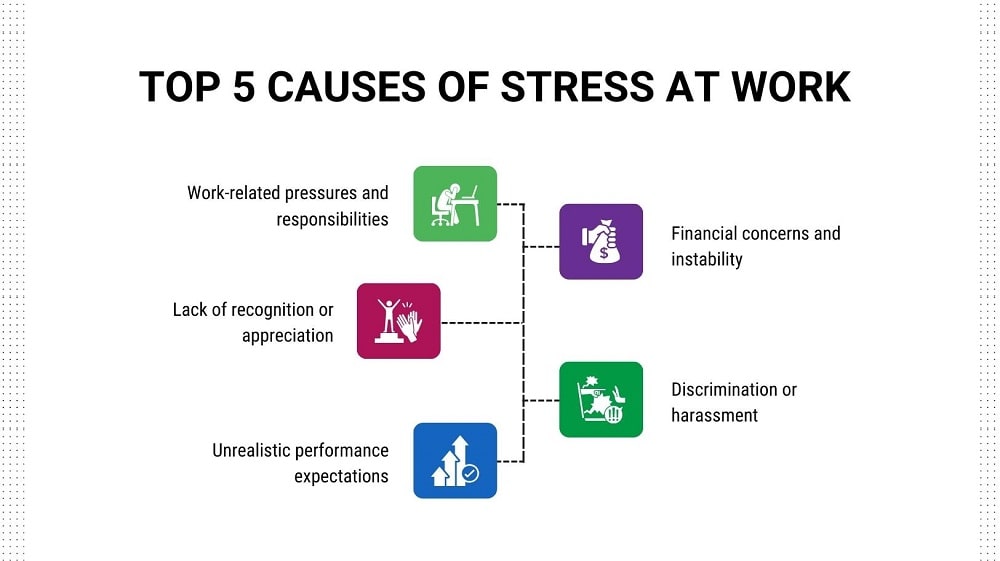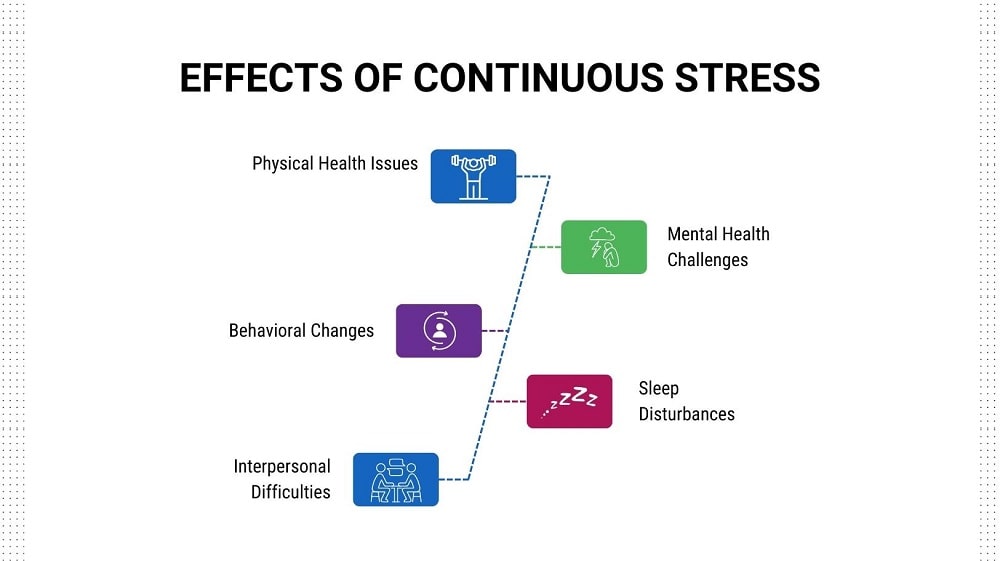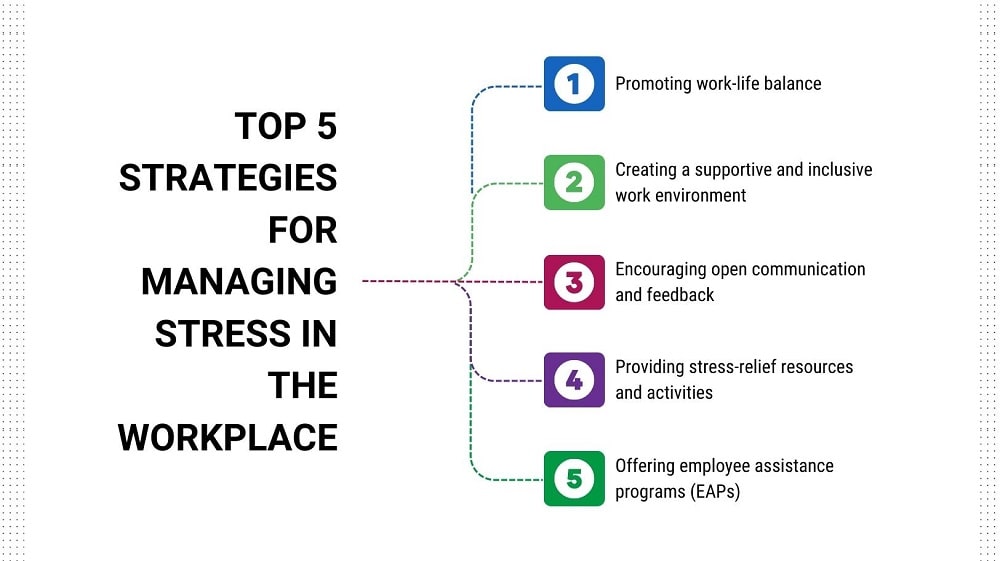Have you ever experienced those tough job days where, regardless of how difficult you try, you can’t seem to focus?
Well, one factor that might be causing this is stress – that unwanted feeling that often troubles us at the workplace.
According to ‘The American Institute of Stress,’ a staggering 80% of workers feel stressed on the job, and nearly half of them admit they need help learning how to manage stress. Additionally, 42% believe their coworkers also require such assistance.
This stress not only affects individuals but also has significant repercussions for companies, leading to losses of around $300 billion each year due to missed workdays and medical expenses.
In any workplace, some level of stress is normal, but excessive stress can harm team spirit and productivity. As a supportive leader, you could be wondering exactly how you can help your employees feel much less stressed out and productive at their best. If that’s the case, this overview is tailor-made for your concerns about stress in the work environment.
So, stay on this page as I have compiled a list of essential and practical techniques and strategies in the post to effectively address the issue.
What is stress?
Stress is an all-natural action of our bodies when faced with tough situations that exceed our coping abilities. It can be triggered in the workplace by hefty work, tight due dates, interpersonal conflicts, or work instability, resulting in physical and psychological strain.
What is stress management in the workplace?
Effective stress management in the office encompasses a collection of methods targeted at decreasing workers’ stress levels while also cultivating a healthier, enjoyable, and highly productive atmosphere. To take care of stress and anxiety properly in your company, it is essential to begin on top with executives and gradually make it part of the entire office.
It means you must carefully plan and implement a stress management program to achieve the desired results. Regular analyses are necessary to ensure the strategies utilized are effective. Simply offering occasional wellness meetings or sporadic yoga sessions is not enough. Stress management must become essential to your company culture and daily operations.
By prioritizing stress management, businesses can reap substantial rewards, including improved employee well-being and significant cost savings.
Research at Harvard has shown that investing in workplace wellness programs saves companies $2.73 for every dollar spent on absence-related expenses.
Although incorporating stress management into your workplace may pose challenges, the long-term benefits outweigh the efforts. By fostering a supportive and stress-conscious culture, your organization can create an environment where your employees thrive, resulting in increased productivity and overall success.
Top 5 causes of stress at work

Stress can occur for a variety of reasons in the workplace. Key reasons to consider:
1. Work-related pressures and responsibilities
According to Better Health, work-related pressure and responsibility is the common reason for stress for the employee.
Even The American Institute of Stress data show that work-related stress causes 120,000 deaths and results in $190 billion in healthcare costs yearly!
Tight deadlines, high workloads, challenging tasks, or the need to meet performance targets trigger work-related stress, leading individuals to experience feelings of overwhelm and pressure.
2. Financial concerns and instability
Many employees feel anxious due to financial stress. This happens when a person needs more money, has too many debts, worries about job security, or faces unexpected expenses. It’s scary not to meet basic needs or reach financial goals, which can affect mental well-being.
A study by NHIS found that higher financial worries lead to more psychological stress.
This shows how important it is to deal with financial stress to manage an employee’s mental health and overall well-being.
3. Lack of recognition or appreciation
In a recent Reward Gateway study, 66% of U.S. employees agreed that their work well-being would improve if they were thanked for their hard work.
This highlights the relevance of recognition and appreciation in the workplace. When employees’ efforts and initiatives go unrecognized by their superiors or peers, they might experience anxiety and a sense of being undervalued.
4. Discrimination or harassment
Discrimination and harassment significantly affect employees’ confidence, self-esteem, and mental health which gives feelings of isolation, stress, and anxiety, to employees.
5. Unrealistic performance expectations
When employees are expected to fulfill impossibly high targets or accomplish unrealistic goals, it can cause a constant feeling of pressure and stress. The anxiety of falling short of these assumptions can adversely influence their wellness and work efficiency.
Understanding these above-listed stress causes is important as they improve your ability to handle your team. But recognizing the effect of stress is equally important for early detection and elimination. Now, in the next section, let’s discuss these telltale effects of stress.
Effects of continuous stress

Continuous stress can affect an employee’s physical, emotional, and mental well-being. Here are five common effects:
👉 Physical Health Issues
Prolonged exposure to stress can bring about various physical health issues. It can damage the body’s immune system, making you much more susceptible to ailments and infections.
👉 Mental Health Challenges
Constant stress can trigger or intensify conditions like panic disorder, post-traumatic stress disorder (PTSD), and generalized anxiety problems (GAD). Continuous stress can additionally negatively impact cognitive function, memory, and concentration, making it hard to focus and make decisions.
👉 Behavioral Changes
People experiencing persistent anxiety may display changes in behavior. They may create unhealthy coping mechanisms like overeating or turning to alcohol, drugs, or other harmful substances to deal with stress.
👉 Sleep Disturbances
Stress can dramatically interfere with sleep patterns. Insomnia or difficulty falling and staying asleep are consequences of long-term stress. Poor rest quality can further worsen stress, producing a vicious circle that affects total wellness.
👉 Interpersonal Difficulties
Consistent stress can strain relationships with family, friends, and also coworkers. The emotional and behavioral changes associated with stress and anxiety could lead to conflict, communication problems, and a basic withdrawal from social communication.
Top 5 Strategies for managing stress in the workplace

Now that you have understood the effect of stress, let’s discover five of the finest strategies that can help you relieve it from your team.
Nonetheless, you should also remember that each worker is unique, so ensure to personalize these methods to match your specific requirements.
1. Promoting work-life balance
Promoting work-life balance is vital for the employee’s wellness and effectiveness at the workplace. Promoting work-life balance entails acknowledging that team members have personal lives and commitments outside the work. As a leader, you can promote this by offering your workers flexible working hours and remote job choices with paid time-off plans that help workers relax and rest. As a result of a healthier work-life balance, your employee can reduce their anxiety, avoid exhaustion, and maintain their psychological and physical health and wellness.
2. Creating a supportive and inclusive work environment
When employees feel valued, appreciated, and supported by their leaders and partners, it reduces the feeling of isolation and stress. As a leader, you can foster inclusivity by promoting diversity, providing equal opportunities, and eliminating workplace discrimination policies. A sense of belonging and support can help team members handle stress appropriately and enhance work satisfaction.
3. Encouraging open communication and feedback
Having interaction is very important for managing stress and anxiety in the workplace. To perform this in your organization, you can develop an atmosphere where staff members feel comfortable sharing their issues, responses, and suggestions without judgment. Also, regular check-ins for assessing work duties and knowing the factors for stress can aid in determining the problems early and proactively resolving them.
Read more: How you can create a thriving workplace with employee feedback!
4. Providing stress-relief resources and activities
You can give sources and perform tasks to assist your employees in taking care of anxiety. These methods include establishing relaxation areas and meditation sessions in your offices. In addition, organizing team-building tasks, health care, and workout workshops can also decrease anxiety and stress and boost a healthy and balanced work environment. By providing the tools and the opportunity to manage stress, you demonstrate your dedication to your team members’ health and job fulfillment.
5. Offering employee assistance programs (EAPs)
Employee support programs or EAPs are useful sources you can offer your workers for their mental and physical wellness. EAPs normally consist of personal counseling, financial and lawful advice, and various other comparable programs. These programs can assist your staff member in dealing with personal as well as work-related stress factors, supplying a tool to review the challenges with professionals. So, by giving EAPs, you show devotion towards your employee and can handle the situation before worsening.
Importance of stress management in the workplace
Workplace stress management is important as it enhances employee wellness and performance. Successfully taking care of stress reduces the threat of burnout, a state of emotional and physical exhaustion resulting from extended stress and anxiety.
By promoting stress management, you can promote a healthier and more favorable workplace, ensuring team members can handle challenges, maintain their mental wellness, and sustain high work performance.
Prioritizing stress and anxiety management empowers employees to strike a balance between professional and personal life, leading to increased job satisfaction and overall organizational success.
Lead a stress-free work life
Stress is a common problem in the office and can have an unfavorable impact on employees and employers. There are several things managers can do to assist workers take care of stress, including promoting work-life balance, producing a supportive and comprehensive work environment, motivating open interaction and feedback, and offering stress-relief sources and activities.
By taking these steps, as a manager you can help produce a healthier and more effective workplace for everybody.




















No Comments